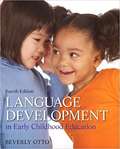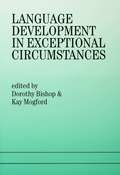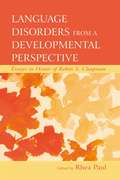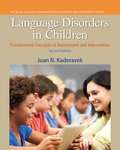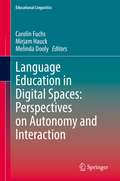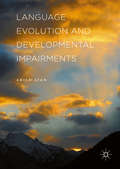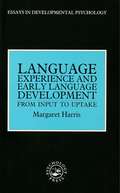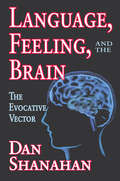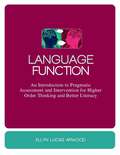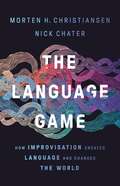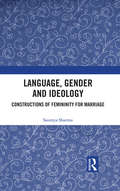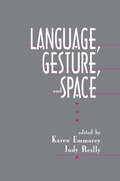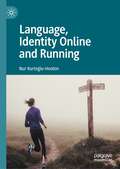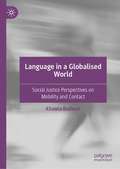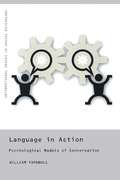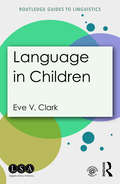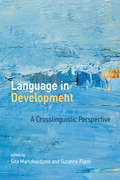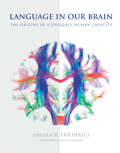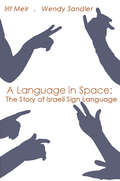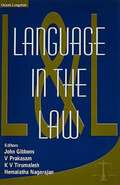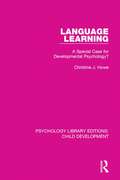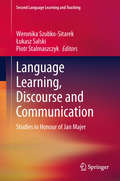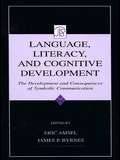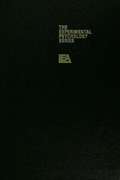- Table View
- List View
Language Development in Early Childhood Education
by Beverly W. OttoWritten by Beverly Otto, Language Development in Early Childhood Education, 4/e efficiently combines theory, research, and practice to provide a solid foundation for understanding language development in children birth through age eight. A comprehensive resource, it focuses on the development of phonological, semantic, syntactic, morphemic, and pragmatic language skills, children's understanding of written language, and ways in which this acquisition process can be enhanced in early childhood settings. Exact guidance on how to develop classrooms and other learning environments that enhance children's language development is also provided. Every chapter begins with interesting vignettes of young children's language development, and throughout all the chapters, readers will discover anecdotal narratives to illustrate key concepts and interaction strategies.
Language Development In Exceptional Circumstances
by Dorothy Bishop Kay MogfordEver since attempts were made to describe and explain normal language development, references to exceptional circumstances have been made. Variations in the conditions under which language is acquired can be regarded as natural experiments, which would not be feasible or ethical under normal circumstances. This can throw light on such questions as: *What language input is necessary for the child to learn language? *What is the relationship between cognition and language? *How independent are different components of language function? *Are there critical periods for language development? *Can we specify necessary and sufficient conditions for language impairment? This book covers a range of exceptional circumstances including: extreme deprivation, twinship, visual and auditory impairments, autism and focal brain damage? Written in a jargon-free style, and including a glossary of linguistic and medical terminology, the book assumes little specialist knowledge. This text is suitable for both students and practitioners in the fields of psycholinguistics, developmental and educational psychology, speech pathology, paediatrics and special education.
Language Disorders From a Developmental Perspective: Essays in Honor of Robin S. Chapman (New Directions in Communication Disorders Research)
by Rhea PaulThe last 25 years have witnessed an explosion of research at the intersection of typical language development and child language disorders. A pioneer in bringing these fields of study together is Robin S. Chapman, Emerita, University of Wisconsin. This contributed volume honors her with chapters written by former students and colleagues, who track in their own research the theme of psycholinguistic contributions to our understanding of the nature and remediation of child language disorders. In this volume, such renowned researchers in child language development as Dorothy Bishop, Judith Johnston, and Ray Kent, among others, discuss their research in certain populations in the context of the significance of, limits of, and alternatives to Robin Chapman’s developmental interactionist perspective. Studies of disordered language in Down’s Syndrome and Specific Language Impairment, in particular, attribute much progress in our understanding of the pragmatic and comprehension skills in these populations to the developmental perspective. Language Disorders From a Developmental Perspective opens with a reprint of Robin Chapman’s seminal 2001 article from The Journal of Child Psychiatry and Psychology. It concludes with a new chapter from Dr. Chapman summarizing what we know and what we don’t know about language disorders within the developmental framework, and pointing to future areas of research and intervention. Clinicians as well as scholars will benefit from this book, as will students in programs of developmental psycholinguistics, child language disorders, and learning disabilities.
Language Disorders in Children: Fundamental Concepts of Assessment and Intervention
by Joan N. KaderavekThis text is more than an introductory look at language disorders. It goes beyond basic concepts and basic definitions to teach students how to analyze, synthesize, evaluate, and link the information they are learning. It offers readers opportunities for higher-order learning, while preparing students to become careful evaluators of information, as well as adept problem solvers. Organized by disorder groups and theme, Language Disorders in Children, 2/e helps students easily make connections between theoretical information and clinical practice through a number of thoughtful features such as case histories, clinical decision trees, and hot topic discussions. It's an approach that meets the needs of today's students to learn lifetime critical thinking skills, to see relationships between isolated ideas and facts, and to think like a speech-language pathologist.
Language Education in Digital Spaces: Perspectives on Autonomy and Interaction (Educational Linguistics #52)
by Carolin Fuchs Mirjam Hauck Melinda DoolyThis book brings together contributions on learner autonomy from a myriad of contexts to advance our understanding of what autonomous language learning looks like with digital tools, and how this understanding is shaped by and can shape different socio-institutional, curricular, and instructional support. To this end, the individual contributions in the book highlight practice-oriented, empirically-based research on technology-mediated learner autonomy and its pedagogical implications. They address how technology can support learner autonomy as process by leveraging the affordances available in social media, virtual exchange, self-access, or learning in the wild (Hutchins, 1995). The rapid evolution and adoption of technology in all aspects of our lives has pushed issues related to learner and teacher autonomy centre stage in the language education landscape. This book tackles emergent challenges from different perspectives and diverse learning ecologies with a focus on social and educational (in)equality. Specifically, to this effect, the chapters consider digital affordances of virtual exchange, gaming, and apps in technology-mediated language learning and teaching ranging from instructed and semi-instructed to self-instructed contexts. The volume foregrounds the concepts of critical digital literacy and social justice in relation to language learner and teacher autonomy and illustrates how this approach may contribute to institutional objectives for equality, diversity and inclusion in higher education around the world and will be useful for researchers and teachers alike.
Language Evolution and Developmental Impairments
by Arild LianThis book gives an account of developmental language impairment from the perspective of language evolution. Components of language acquisition and specific language impairments can be mapped to stages in the evolutionary trajectory of language. Lian argues that the learning of procedural skills by early ancestors has served as pre-adaptation of grammar. The evolutionary perspective gives rise to a re-evaluation of developmental impairment with respect to diagnostic terminology and methods of treatment. Chapters within cover topics such as dyslexia, the cultural mediation of language evolution and the cross-modality of language. Turn-taking in marmoset monkeys is considered as a pre-adaptation to dialogue in humans, and the role of infant-caregiver interactions is discussed. Language Evolution and Developmental Impairments will be of interest to linguists, psychologists and neurobiologists interested in the intersection of these subjects, as well as scholars of language acquisition and language impairment.
Language Experience and Early Language Development: From Input to Uptake (Essays in Developmental Psychology)
by Margaret HarrisAddresses one debate in language development, namely the relationship between children's language development and their language experience.
Language, Feeling, and the Brain: The Evocative Vector
by Daniel ShanahanLinguistic theory since the Cognitive Revolution has fol- lowed one of the premises of that revolution by largely sidelining the issue of emotions and concentrating on those aspects of language that are more strictly cognitive. However, during the last ten years research in cognitive science, especially in neuropsychology, has begun to fill in the gaps left by the exclusion of emotions from cognitive research. The work of those like Oatley, Zajonc, Damasio, and LeDoux, to name a few, has demonstrated both that it is possible to construct models of how emotions play into the workings of the psyche and that they are necessary in giving us a balanced view of the human mind. Language, Feeling, and the Brain attempts to apply the fruits of this new research in emotion to our understanding of language itself. Building on Karl Pribram's integrated model of emotions and motivations, the book takes an eclectic approach to explaining how emotions contribute to the nature of language, drawing on research done in neuropsychology, philosophy, cognitive linguistics, anthropology, and related fields. Its aim is to construct a propositional model for how the emotions may have contributed to the emergence of symbolic formation, most especially in the forms of gesture and speech, and how identifying that emotional influence sheds new light on everything we have had to say about language itself, from lexis and grammar to culture and literature.
Language Function
by Ellyn Lucas ArwoodLiteracy teaching tends to take a structural approach to language, focusing on auditory products or skills such as sounds, morphemes, words, sentences, and vocabulary. However, new research suggests that the majority of English speakers actually think and learn in visual concepts, and that there is a cultural and linguistic mismatch between auditory teaching methods and the way students think and learn. This has important implications for all educators including those who work with students with neurogenic disabilities, such as autism spectrum disorders and ADHD. In her new book, Dr. Ellyn Lucas Arwood outlines a revolutionary four-tiered model of how a learner acquires language, and suggests ways to impose visual language functions onto an auditory language like English in order to improve learning for both neurotypical learners and those with neurogenic disabilities. Dr. Arwood provides tried-and-tested intervention strategies that work with all levels of ability, giving readers the knowledge and confidence to teach learners to become more literate in a way that raises learners' abilities to think and problem solve. This book takes a fresh look at how language and literacy interact, and will be of interest to educators and special educators, speech and language pathologists, and other professionals who support language learning and development.
The Language Game: How Improvisation Created Language and Changed the World
by Morten H. Christiansen Nick ChaterForget the language instinct—this is the story of how we make up language as we go Language is perhaps humanity&’s most astonishing capacity—and one that remains poorly understood. In The Language Game, cognitive scientists Morten H. Christiansen and Nick Chater show us where generations of scientists seeking the rules of language got it wrong. Language isn&’t about hardwired grammars but about near-total freedom, something like a game of charades, with the only requirement being a desire to understand and be understood. From this new vantage point, Christiansen and Chater find compelling solutions to major mysteries like the origins of languages and how language learning is possible, and to long-running debates such as whether having two words for &“blue&” changes what we see. In the end, they show that the only real constraint on communication is our imagination.
Language, Gender and Ideology: Constructions of Femininity for Marriage
by Saumya SharmaThis book explores multiple facets of femininity for marriage in India. Using language as an entry point, it looks at how and why media representations of gender identities are constructed the way they are. It works with a unique synthesis of second-wave feminist discourse and empirical linguistic research to look at how the social institution of marriage becomes the site of interaction between language, ideology, psyche and culture. This volume also brings together the personal histories and views of women who discuss how media, modernity and social norms shape their ideas about marriage and selfhood. Deconstructing perceptions of femininity in contemporary India, the book will be of great interest to scholars and researchers of sociology, gender studies, linguistics, media and cultural studies and psychoanalysis.
Language, Gesture, and Space
by Karen Emmorey Judy S. ReillyThis book brings together papers which address a range of issues regarding the nature and structure of sign languages and other gestural systems, and how they exploit the space in which they are conveyed. The chapters focus on five pertinent areas reflecting different, but related research topics: * space in language and gesture, * point of view and referential shift, * morphosyntax of verbs in ASL, * gestural systems and sign language, and * language acquisition and gesture. Sign languages and gestural systems are produced in physical space; they manipulate spatial contrasts for linguistic and communicative purposes. In addition to exploring the different functions of space, researchers discuss similarities and differences between visual-gestural systems -- established sign languages, pidgin sign language (International Sign), "homesign" systems developed by deaf children with no sign language input, novel gesture systems invented by hearing nonsigners, and the gesticulation that accompanies speech. The development of gesture and sign language in children is also examined in both hearing and deaf children, charting the emergence of gesture ("manual babbling"), its use as a prelinguistic communicative device, and its transformation into language-like systems in homesigners. Finally, theoretical linguistic accounts of the structure of sign languages are provided in chapters dealing with the analysis of referential shift, the structure of narrative, the analysis of tense and the structure of the verb phrase in American Sign Language. Taken together, the chapters in this volume present a comprehensive picture of sign language and gesture research from a group of international scholars who investigate a range of communicative systems from formal sign languages to the gesticulation that accompanies speech.
Language, Identity Online and Running
by Nur Kurtoğlu-HootonThis book focuses on language and identity online within the context of running from an interdisciplinary perspective. It brings together digital ethnography, existential phenomenology, interpretative phenomenological analysis and sporting embodiment in the pursuit to explore runners’ lived experiences and identities online. Language, identity and identity online are often studied in broader social contexts such as education, culture and politics, and running is intimately related to key issues in contemporary society, such as health and exercise, sport and nationalism, embracing a variety of discourse types and having implications more generally for our identity as human beings. The evolving online media through which people make sense of who they are and which groups they belong to are enabling new ways of realising identities and relationships. This book will be of interest to applied linguists, discourse analysts, as well as those interested in sports, sports psychology, and identity enactment.
Language in a Globalised World: Social Justice Perspectives on Mobility and Contact
by Khawla BadwanThis book takes a critical look at the role of language in an increasingly diversified and globalised world, using the new framework of 'sociolinguistics of globalisation' to draw together research from human geography, sociolinguistics, and intercultural communication. It argues that globalisation has resulted in a destabilisation of social and linguistic norms, and presents a ‘language-in-motion’ approach which addresses the inequalities and new social divisions brought by the unprecedented levels of population mobility. This book looks at language on the individual, national and transnational level, and it will be of interest to readers with backgrounds in history, politics, human geography, sociolinguistics and minority languages.
Language in Action: Psychological Models of Conversation (International Series in Social Psychology)
by William TurnbullFace-to-face conversation between two or more people is a universal form, and perhaps the basic form, of social interaction. It is the primary site of social interaction in all cultures and the place where social and cultural meaning takes shape. Face-to-face conversation between children and parents can also be an important context for social and cognitive development. Given the universality, frequency and importance of conversation in social life, a psychological model of conversation is required for an understanding of the central issues in social and developmental psychology. This book provides such a model.Language in Action presents a critical examination of four models of conversation: the Code model based on Chomsky's linguistic views; the Speech Act model of Austin and Searle; the Inferential model of Grice, and the Conversation Analytic model of Sacks and Schegloff. It also considers the Brown and Levinson model of politeness in conversation. Using many examples from natural talk and drawing on the positive aspects of the reviewed models, Turnbull proposes a new Social Pragmatic model of conversation as social interaction. He also describes the research paradigm of Social Pragmatics that experimental psychologists can use to study conversation. This book will be invaluable for advanced students in psychology, sociology, language and linguistics and communication. It will also make fascinating and lively reading for anyone wanting a greater understanding of this fundamental form of social interaction.
Language in Children (Routledge Guides to Linguistics)
by Eve V. ClarkLanguage in Children provides a concise and basic introduction for students studying child language acquisition for the first time. Starting from the first sounds a child produces, this book covers all the stages a child goes through in acquiring a language. This title: Illustrates developmental stages from the recognition of sounds and words to the ability to hold a conversation, also covering bilingual upbringing and language disorders; Features real-life examples of all the phenomena discussed, from languages such as French, Spanish and Portuguese as well as English; Incorporates guidance on sources for further reading and exploration by chapter; Is supported by a companion website that includes exercises with links to real-world data in the CHILDES archive. Written by an experienced author and teacher, Language in Children is essential reading for students studying this topic.
Language in Development: A Crosslinguistic Perspective
by Edited by Gita Martohardjono and Suzanne FlynnExplorations of language development in different types of learner populations and across various languages.This volume examines language development in different types of learner populations and across various languages. The contributors analyze experimental studies of child and adult language acquisition, heritage language development, bilingualism, and language disorders. They consider theoretical and methodological issues; language development in children, discussing topics that range from gestures to errors in person and number agreement; and development and attrition of (morpho)syntactic constructions in second language learners, bilinguals, and Alzheimer's patients. The approach is "crosslinguistic" in three senses of the word: the contributors offer analyses of acquisition phenomena in different languages; they consider "crosslinguistic influence," or the potential effects of multiple languages on one another in the mind of the same speaker; and (in a novel use of the term, proposed by the editors) the chapters bring together theoretical and methodological approaches pertinent to the linguistics of language development in children, adults, and heritage speakers.
Language in Our Brain: The Origins of a Uniquely Human Capacity (The\mit Press Ser.)
by Angela D. FriedericiA comprehensive account of the neurobiological basis of language, arguing that species-specific brain differences may be at the root of the human capacity for language.Language makes us human. It is an intrinsic part of us, although we seldom think about it. Language is also an extremely complex entity with subcomponents responsible for its phonological, syntactic, and semantic aspects. In this landmark work, Angela Friederici offers a comprehensive account of these subcomponents and how they are integrated. Tracing the neurobiological basis of language across brain regions in humans and other primate species, she argues that species-specific brain differences may be at the root of the human capacity for language.Friederici shows which brain regions support the different language processes and, more important, how these brain regions are connected structurally and functionally to make language processes that take place in milliseconds possible. She finds that one particular brain structure (a white matter dorsal tract), connecting syntax-relevant brain regions, is present only in the mature human brain and only weakly present in other primate brains. Is this the “missing link” that explains humans' capacity for language?Friederici describes the basic language functions and their brain basis; the language networks connecting different language-related brain regions; the brain basis of language acquisition during early childhood and when learning a second language, proposing a neurocognitive model of the ontogeny of language; and the evolution of language and underlying neural constraints. She finds that it is the information exchange between the relevant brain regions, supported by the white matter tract, that is the crucial factor in both language development and evolution.
A Language in Space: The Story of Israeli Sign Language
by Irit Meir Wendy SandlerThis English version of A Language in Space: The Story of Israeli Sign Language, which received the Bahat Award for most outstanding book for a general audience in its Hebrew edition, is an introduction to sign language using Israeli Sign Language (ISL) as a model. Authors Irit Meir and Wendy Sandler offer a glimpse into a number of fascinatin
Language in the Law
by V. Prakasam John Carey John Gibbons K. V. TirumaleshThe Language in the Law records the different modes and practices in the use of language related to law. The nexus between language and the law in various countries and cultures is examined in this book.
Language Learning: A Special Case for Developmental Psychology? (Psychology Library Editions: Child Development #3)
by Christine J. HoweOriginally published in 1993, the starting place for this book is the notion, current in the literature for around 30 years at that time, that children could not learn their native language without substantial innate knowledge of its grammatical structure. It is argued that the notion is as problematic for contemporary theories of development as it was for theories of the past. Accepting this, the book attempts an in-depth study of the notions credibility. Central to the book’s argument is the conclusion that the innateness hypothesis runs into two major problems. Firstly, its proponents are too ready to treat children as embryonic linguists, concerned with the representation of sentences as an end in itself. A more realistic approach would be to regard children as communication engineers, storing sentences to optimize the production and retrieval of meaning. Secondly, even when the communication analogy is adopted, it is glibly assumed that the meanings children impute will be the ones adults intend. One of the book’s major contentions is that a careful reading of contemporary research suggests that the meanings may differ considerably. Identifying such problems, the book considers how development should proceed, given learning along communication lines and a more plausible analysis of meaning. It makes detailed predictions about what would be anticipated given no innate knowledge of grammar. Focusing on English but giving full acknowledgement to cross-linguistic research, it concludes that the predictions are consistent with both the known timescale of learning and the established facts about children’s knowledge. Thus the book aspires to a serious challenge to the innateness hypothesis via, as its final chapter will argue, a model which is much more reassuring to psychological theory.
Language Learning and the Brain: Lexical Processing in Second Language Acquisition
by Ulf SchützeEvery person who encounters or learns another language is faced with the challenge of processing many new words in a short period of time. What are the conditions under which a learner can acquire those words successfully and process them to long-term memory? How do language and memory faculties interact? What role do the senses play in this process? Are factors such as age or individual backgrounds of learners to be considered? Taking the reader on a fascinating journey through the brain to demonstrate how language is processed, Ulf Schütze explains the dynamic environment involved in recording and producing words. The book also discusses how to use information technology, such as Apps, to make the learning of words entertaining and efficient. Describes learning words in another language as a dynamic and fluid process. Provides a strong research base in second language acquisition, psycholinguistics, cognitive psychology, and neurophysiology. Outlines practical applications that are helpful for learners, teachers, researchers, and the general public.
Language Learning, Discourse and Communication
by Weronika Szubko-Sitarek Łukasz Salski Piotr StalmaszczykThis volume brings together papers on a wide spectrum of topics within the broad area of language acquisition, stressing the interconnections between applied and theoretical linguistics, as well as language research methodology. These contributions in honor of Professor Jan Majer have been grouped in two sections: language learning, and discourse and communication. The former discusses issues varying from aspects of first, second, and third language acquisition, individual learner differences (i. e. gender, attitudes, learning strategies), and second language research methodology to the analysis of features of learner spoken language, the role of feedback in foreign language instruction, and the position of culture in EFL textbooks. The second part of the volume offers a theoretical counterbalance to the applied nature of the first one. Here, the contributions touch upon spoken and written language analysis, language awareness, and aspects of the English language; also, selected issues of language philosophy are discussed. The wide range of topics covered in the publication, authored by specialists in their respective areas, reflects Professor Majer's academic interests and corresponds to the complex nature of the general field the volume aims to portray.
Language, Literacy, and Cognitive Development: The Development and Consequences of Symbolic Communication (Jean Piaget Symposia Series)
by Eric Amsel James P. ByrnesLanguage, Literacy, and Cognitive Development addresses the impact of language and literacy on cognitive development. Top researchers examine the cognitive significance of the growth in children's ability to express themselves symbolically, whether that involves communicating linguistically, mathematically, logically, or through some other symbol system expressed in speech, gesture, notations, or some other means. The book contributes to refining and answering questions regarding the nature, origin, and development of symbolic communication in all its forms, and their consequences for the cognitive development of the younger child at home and the older child at school.
Language, Memory, and Thought
by John R. AndersonPublished in 1976, Language, Memory, and thought is a valuable contribution to the field of Cognitive Psychology. This book presents a theory about human cognitive functioning, a set of experiments testing that theory, and a review of some of the literature relevant to the theory. The theory is embodied in a computer simulation model called ACT.
